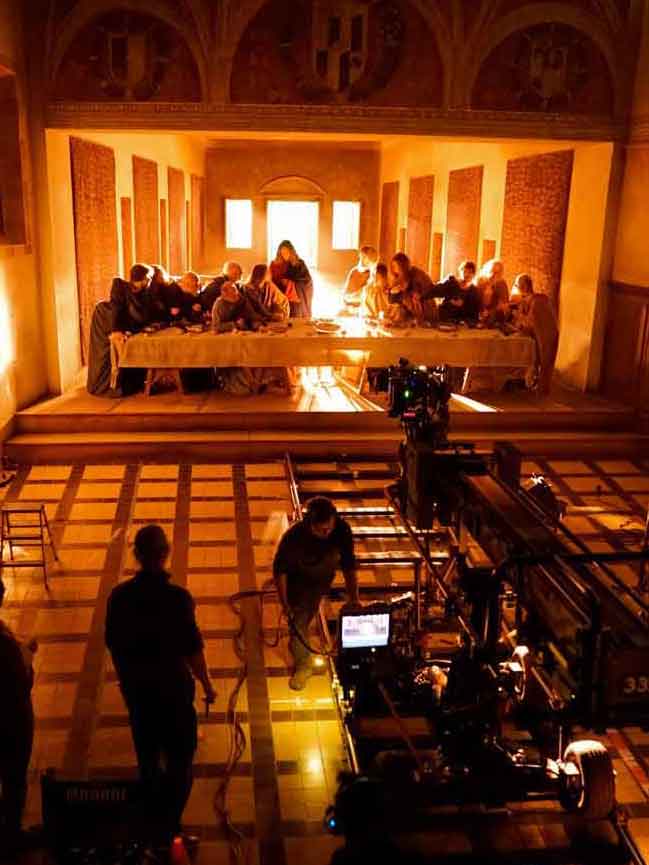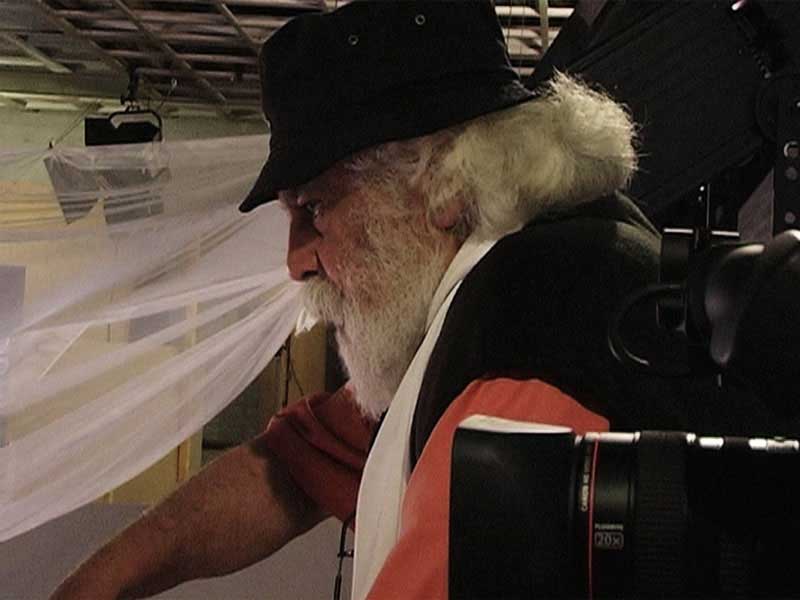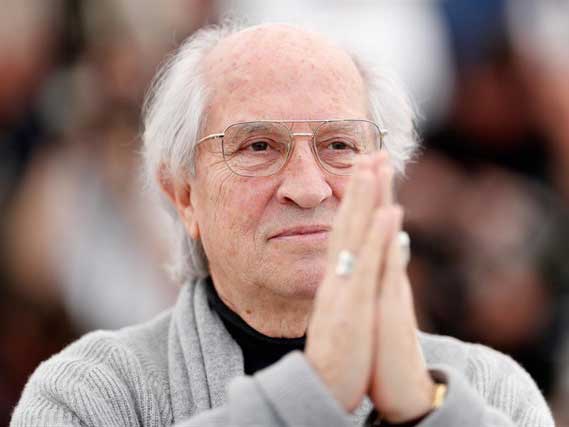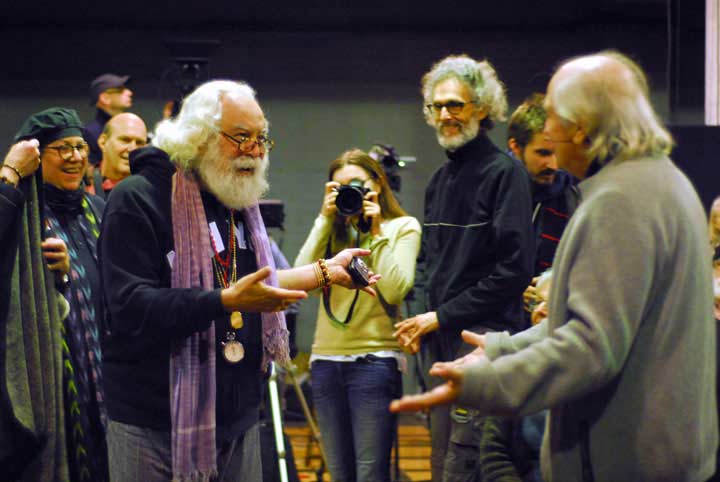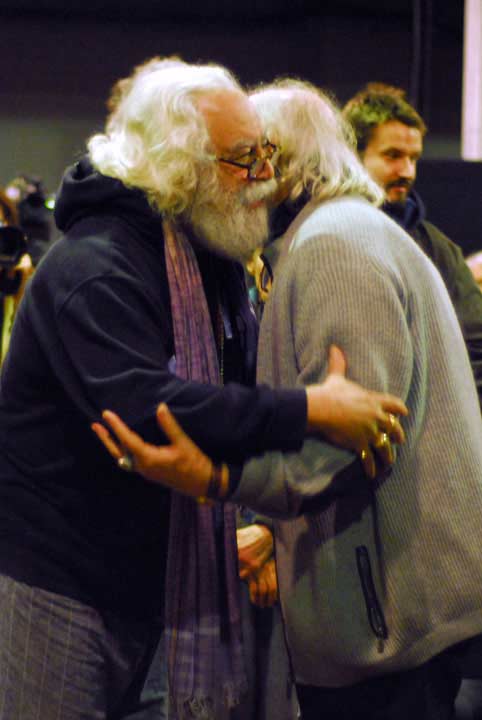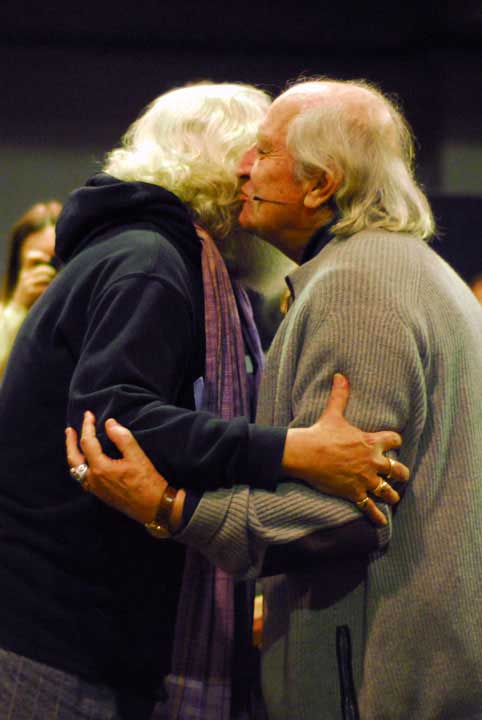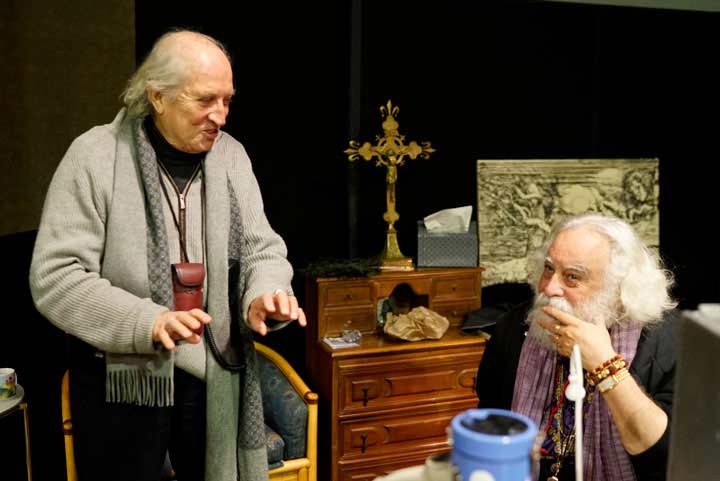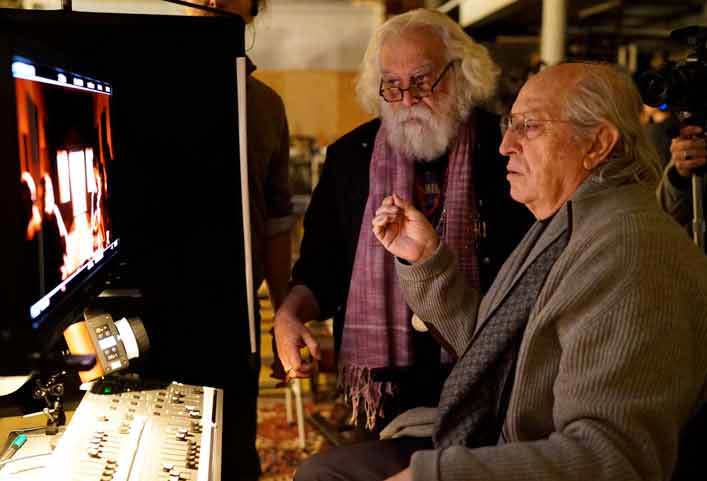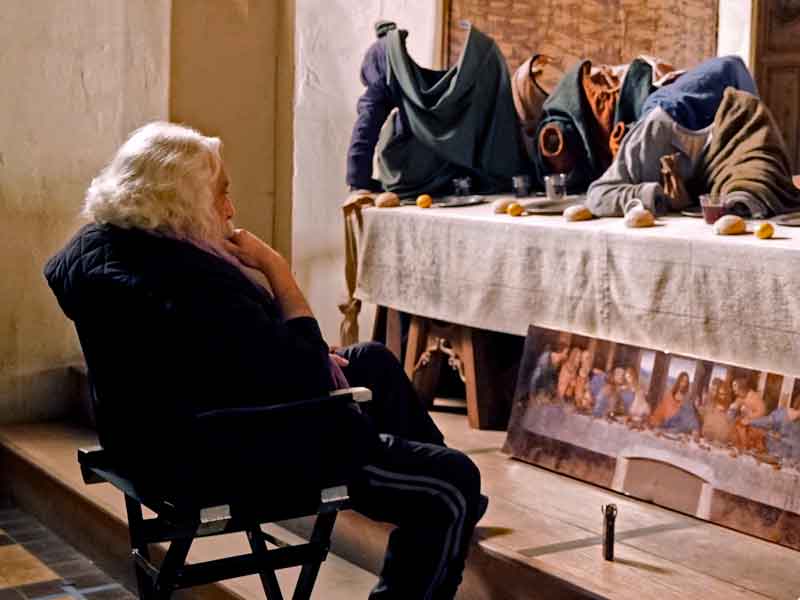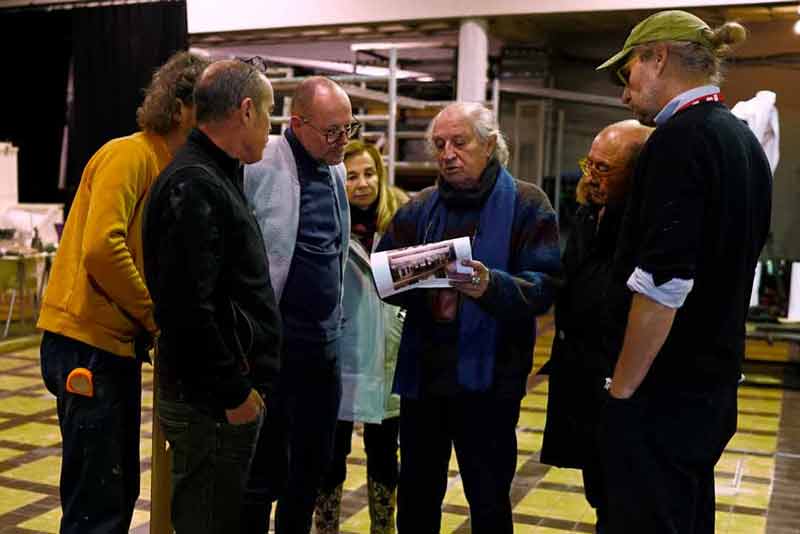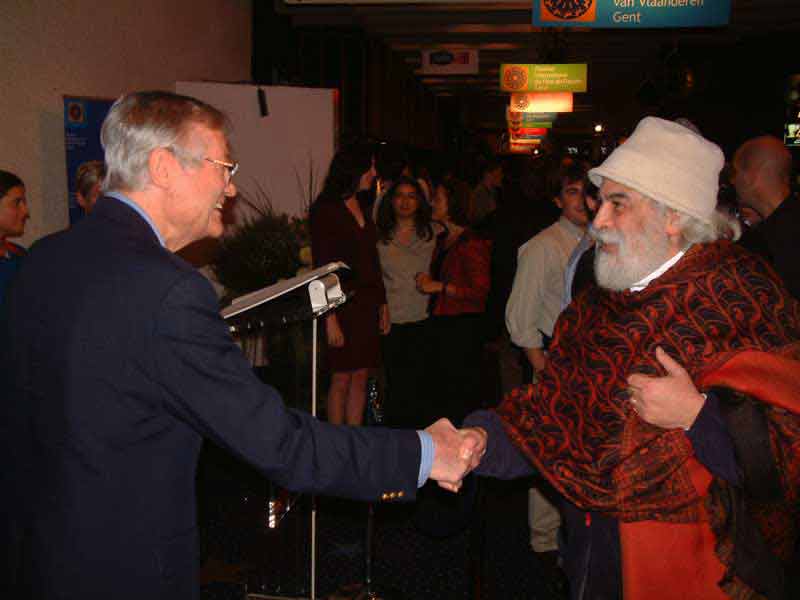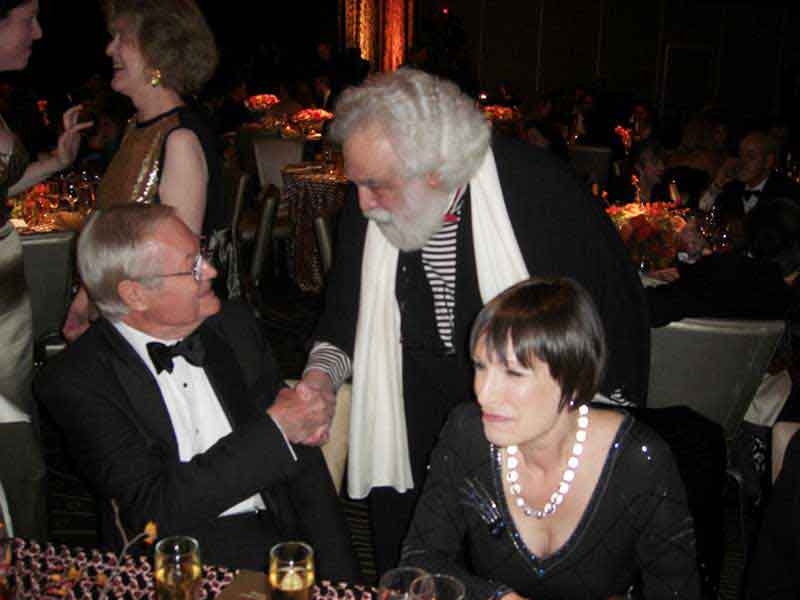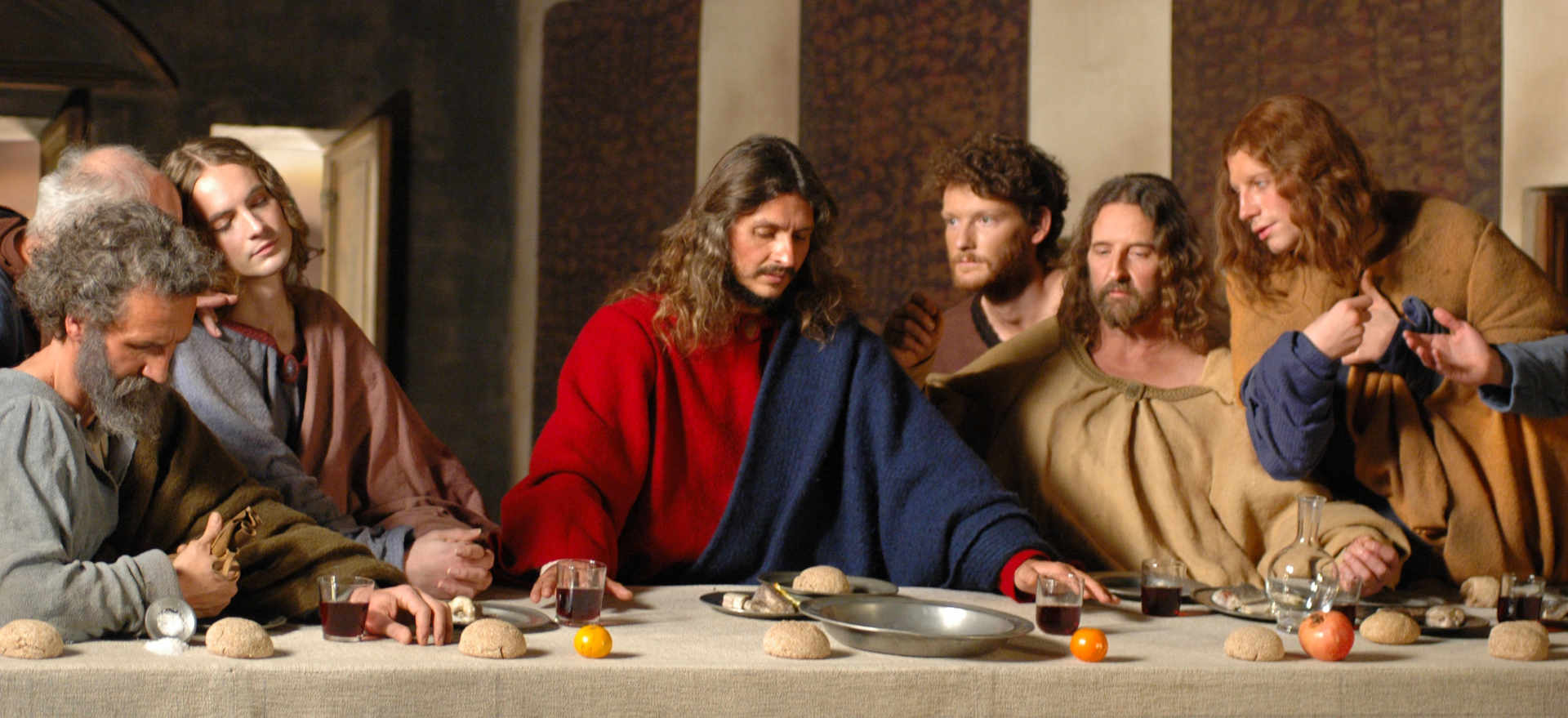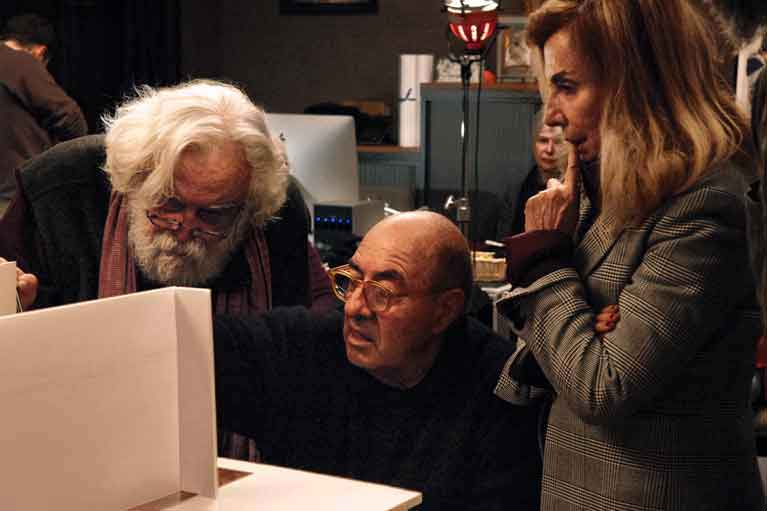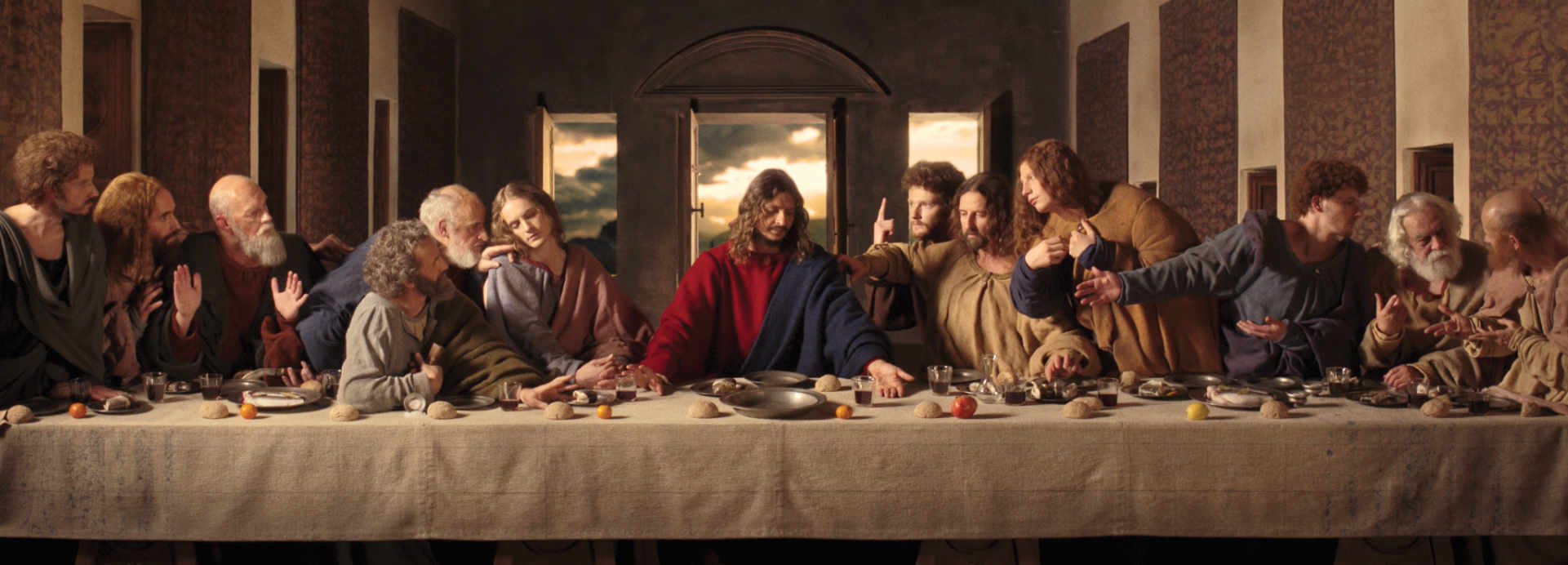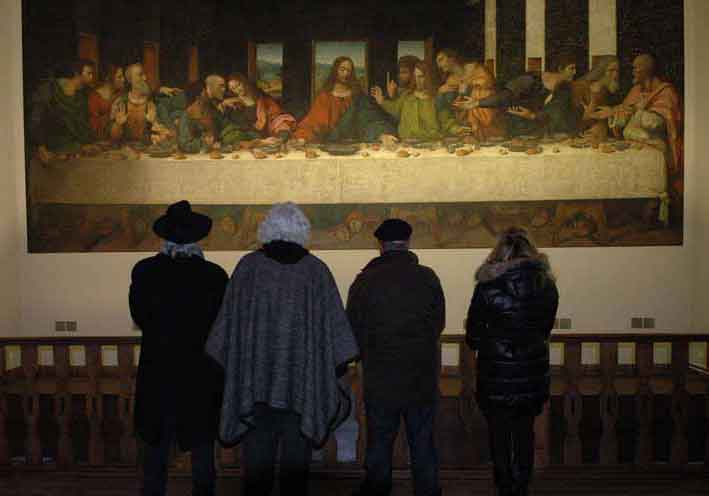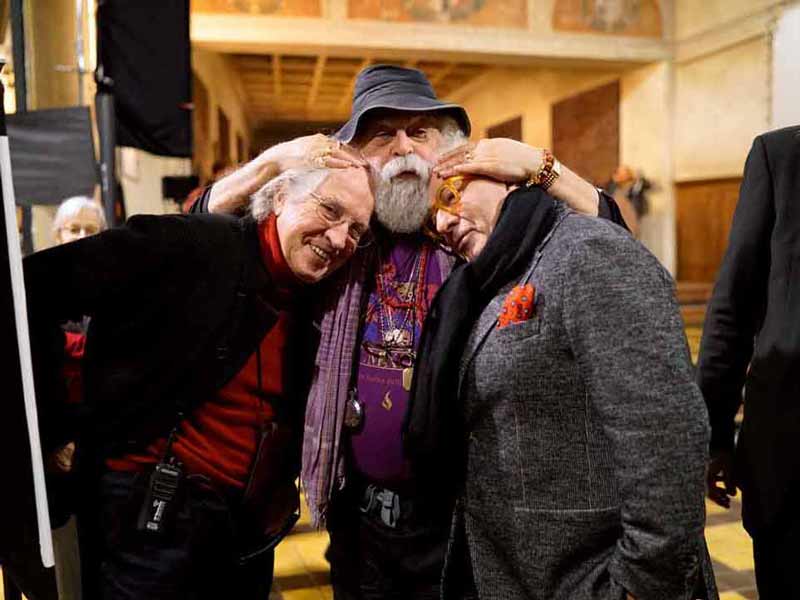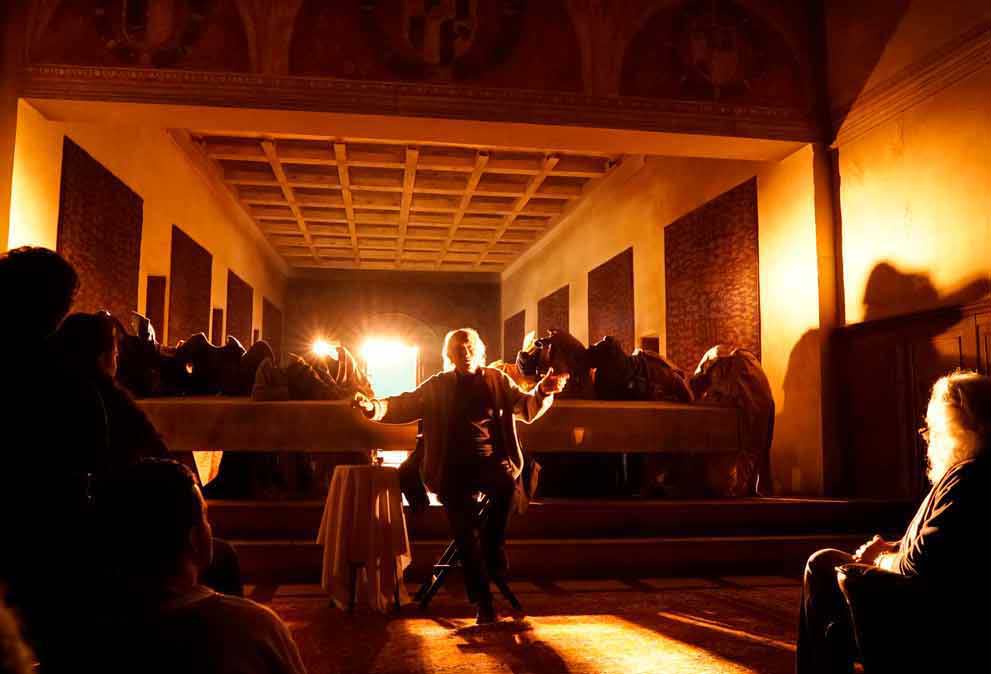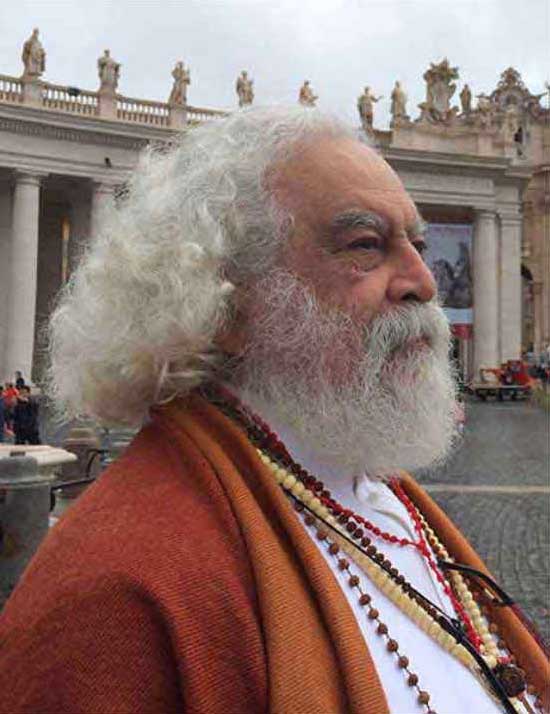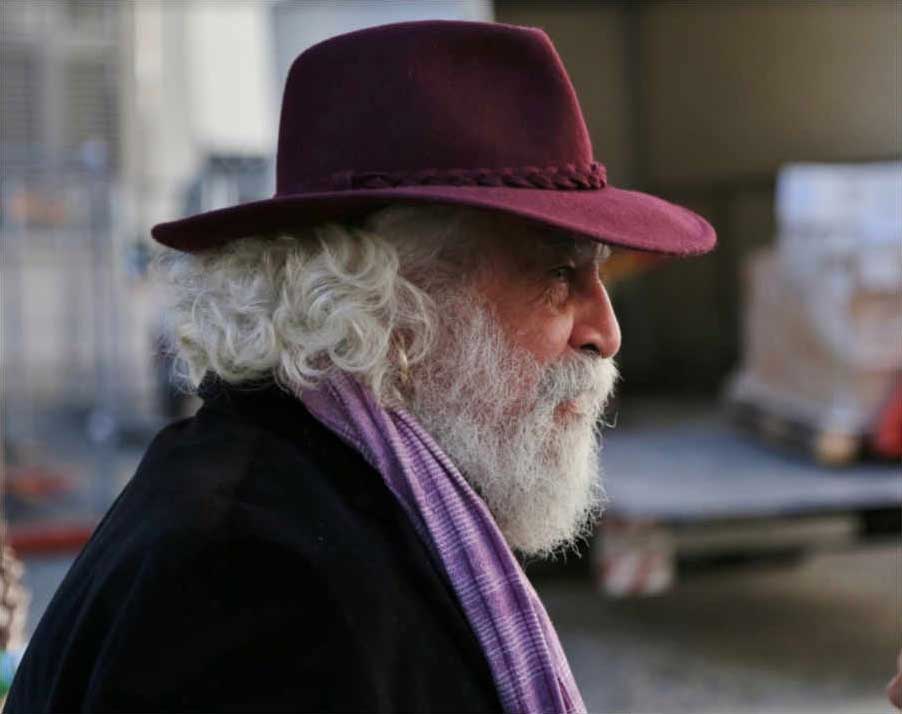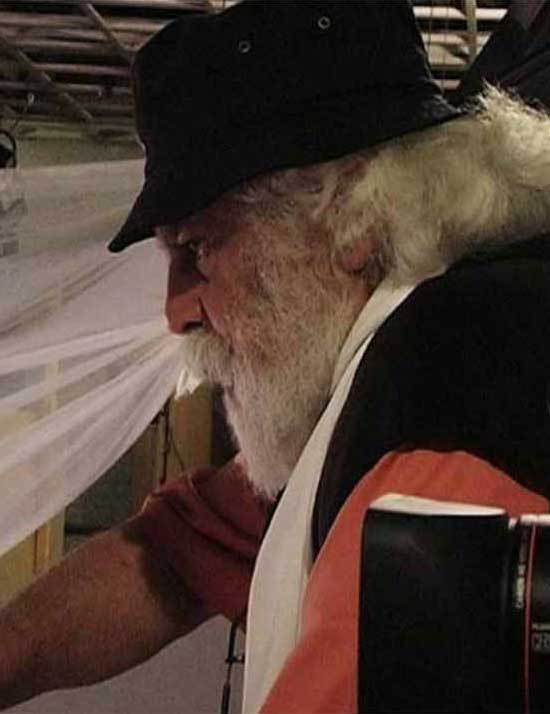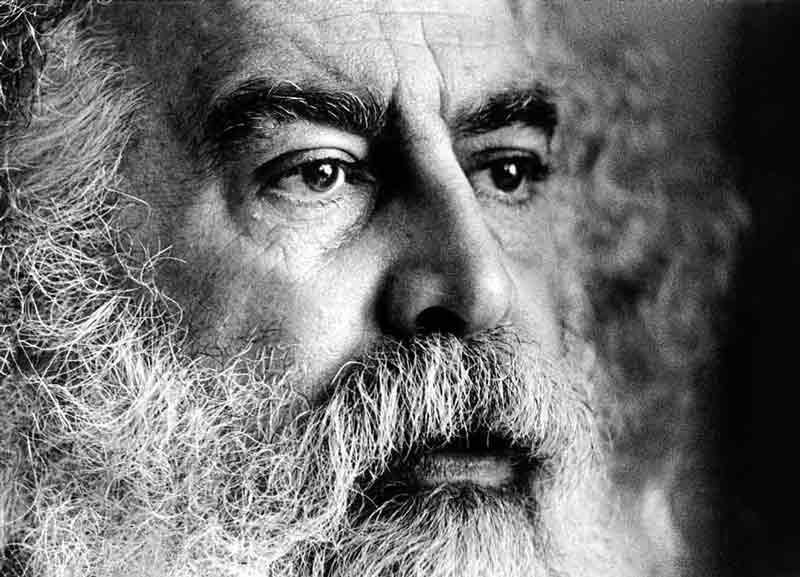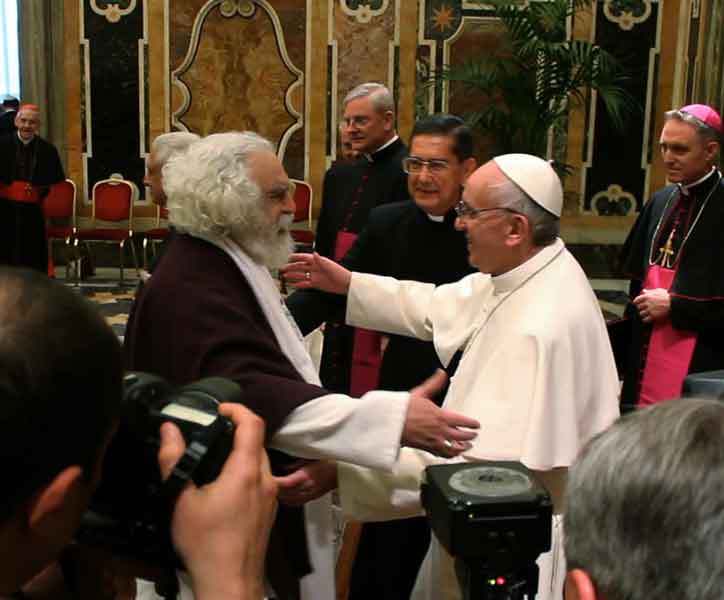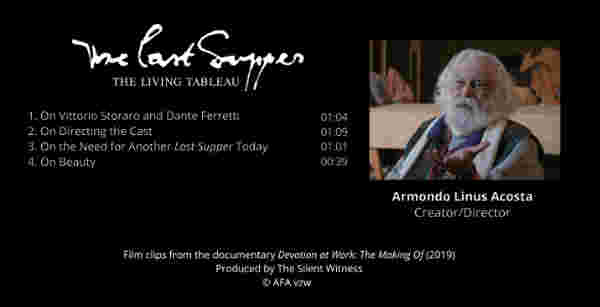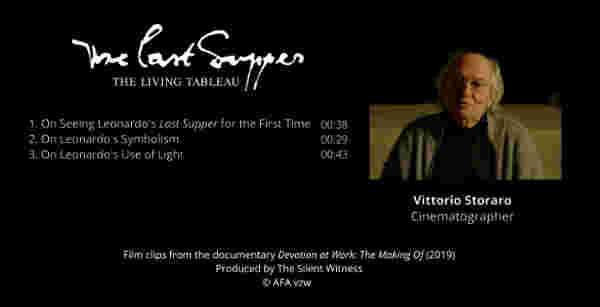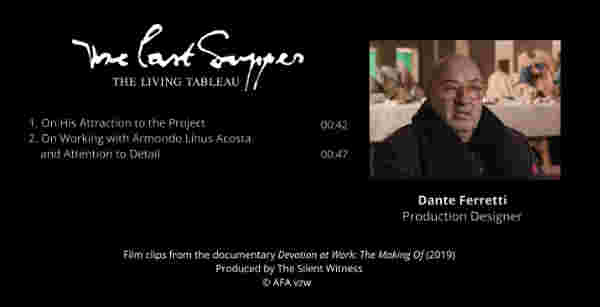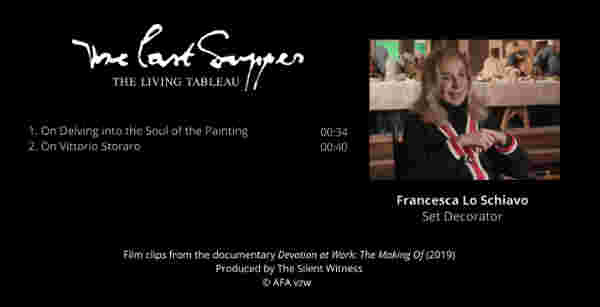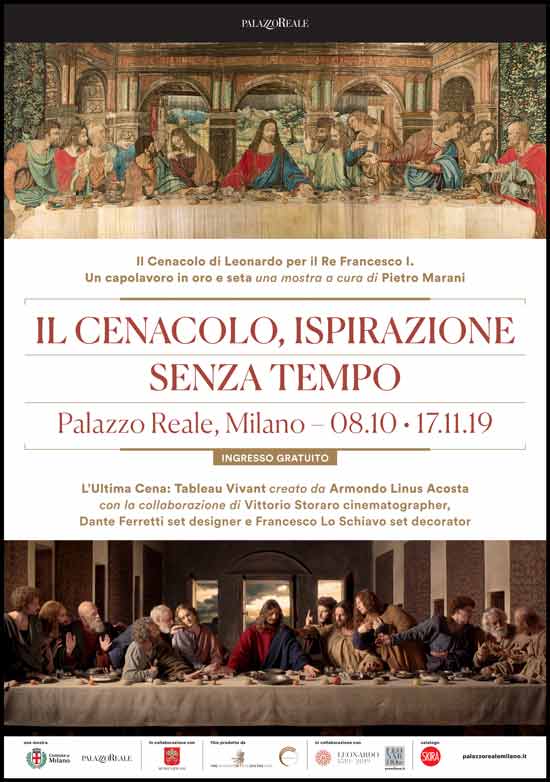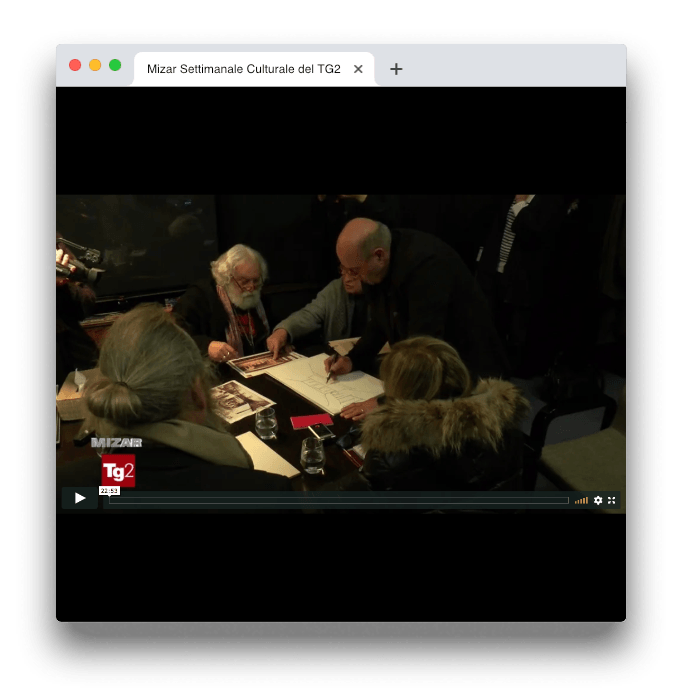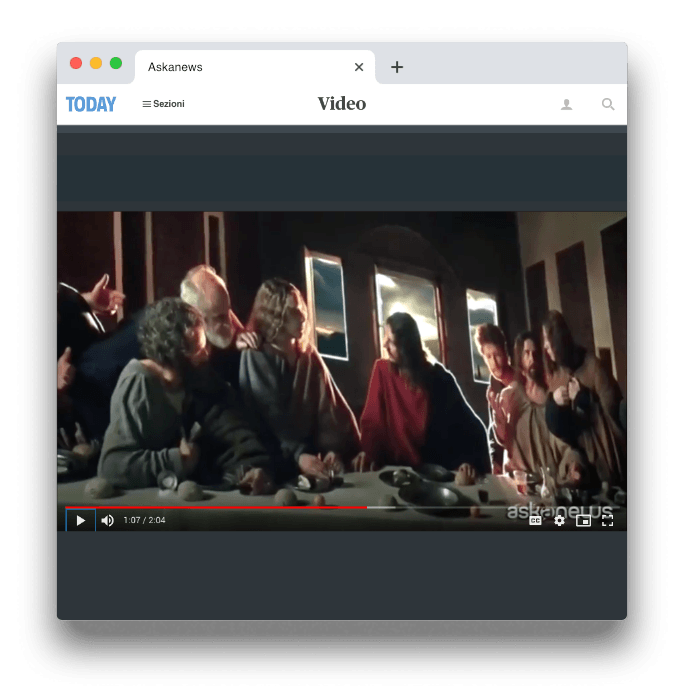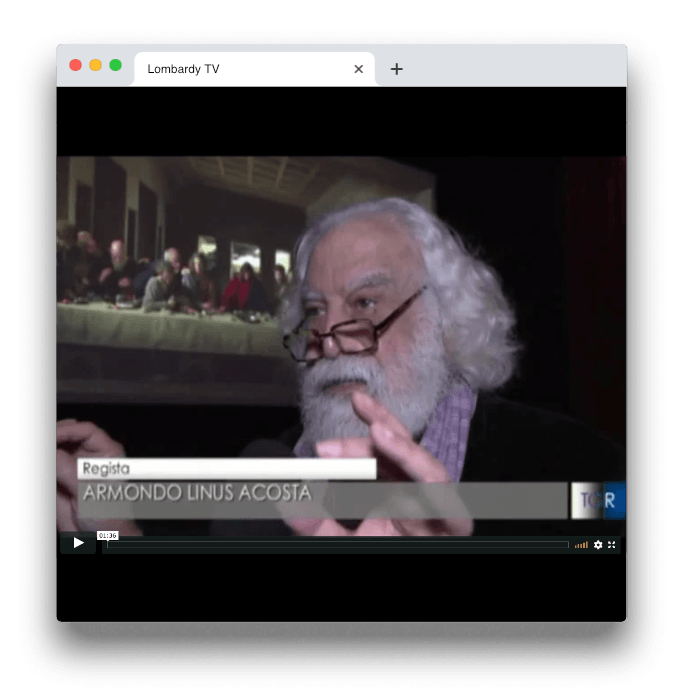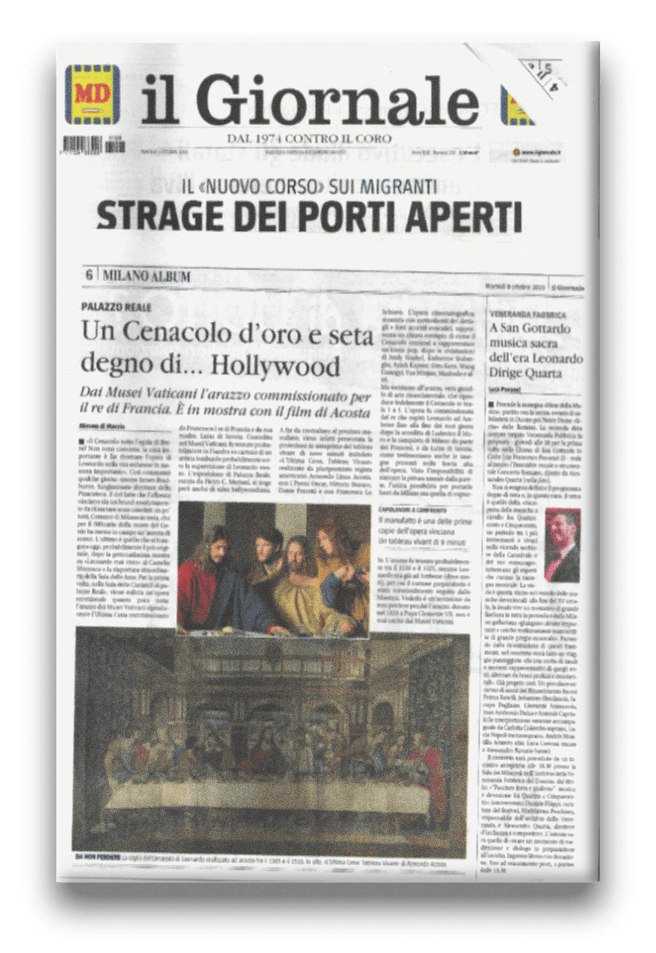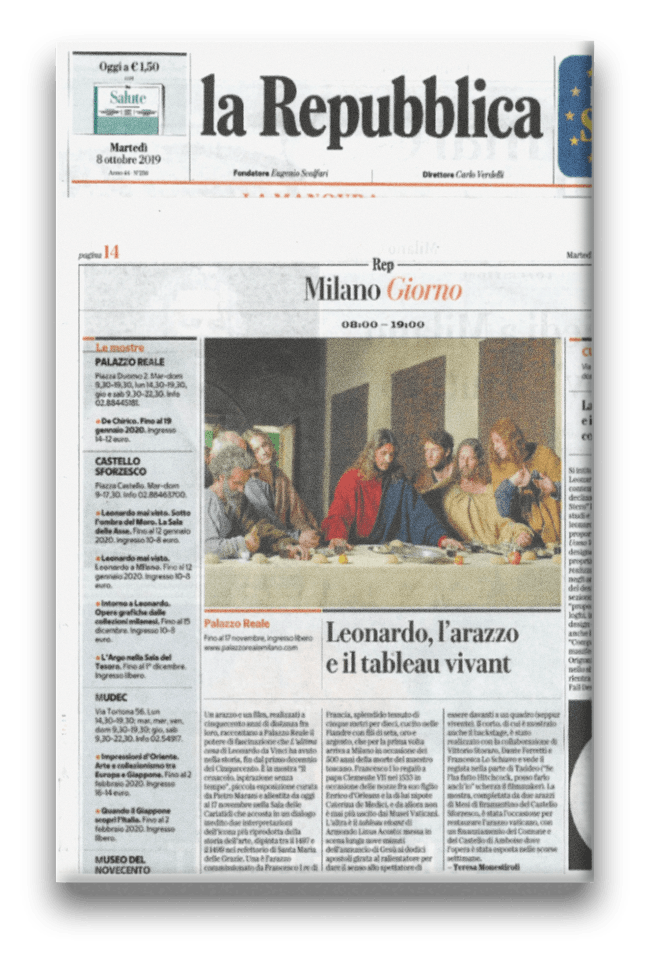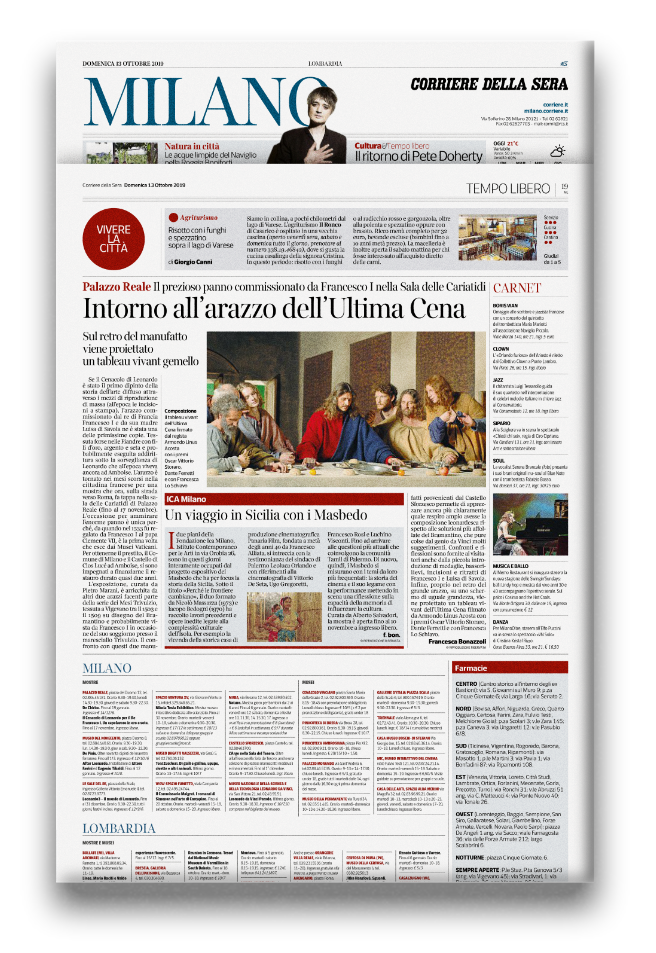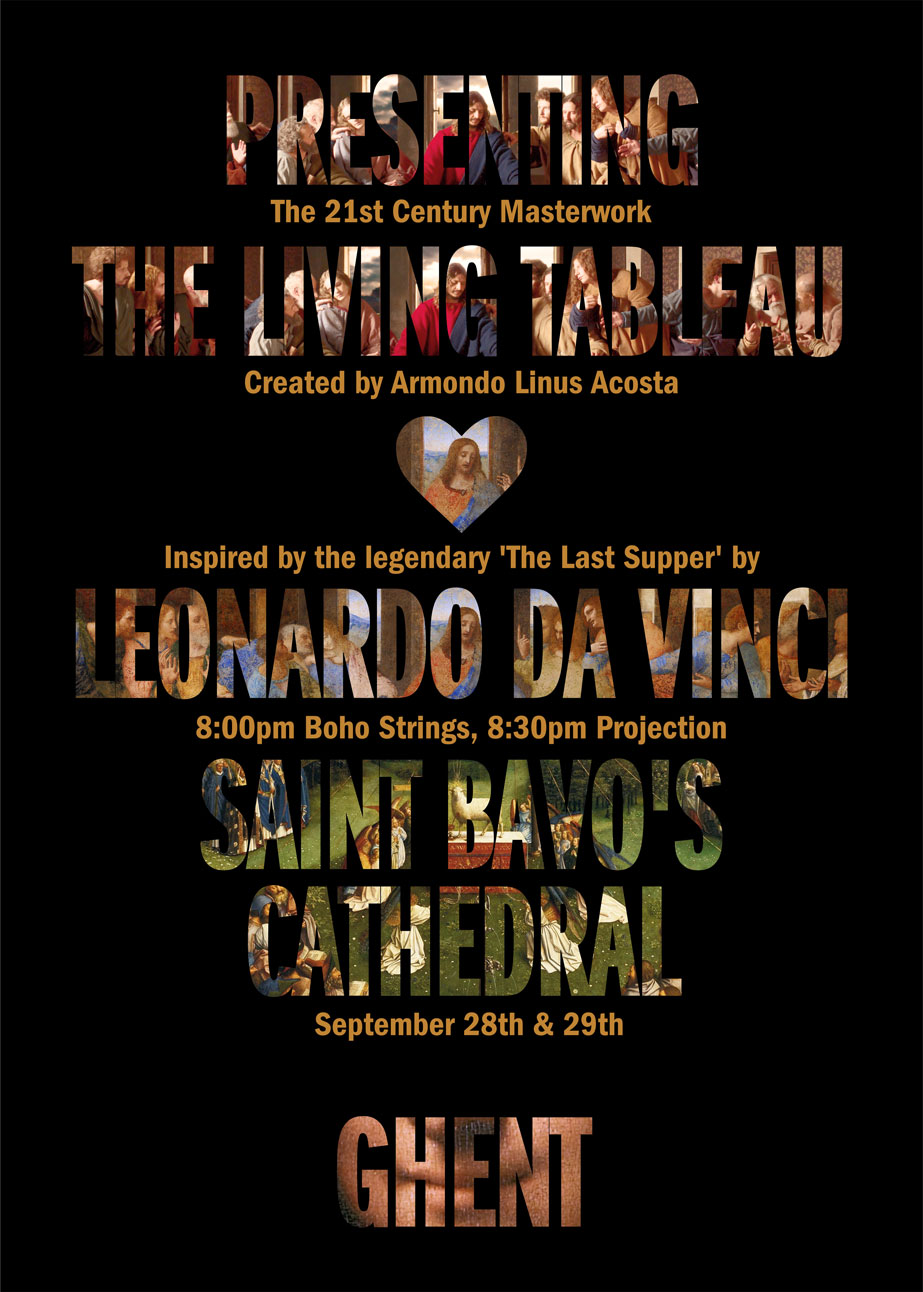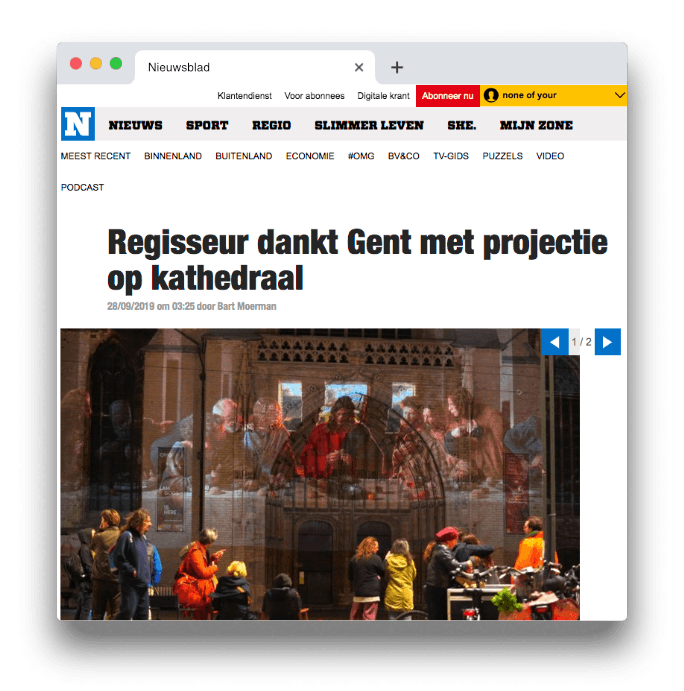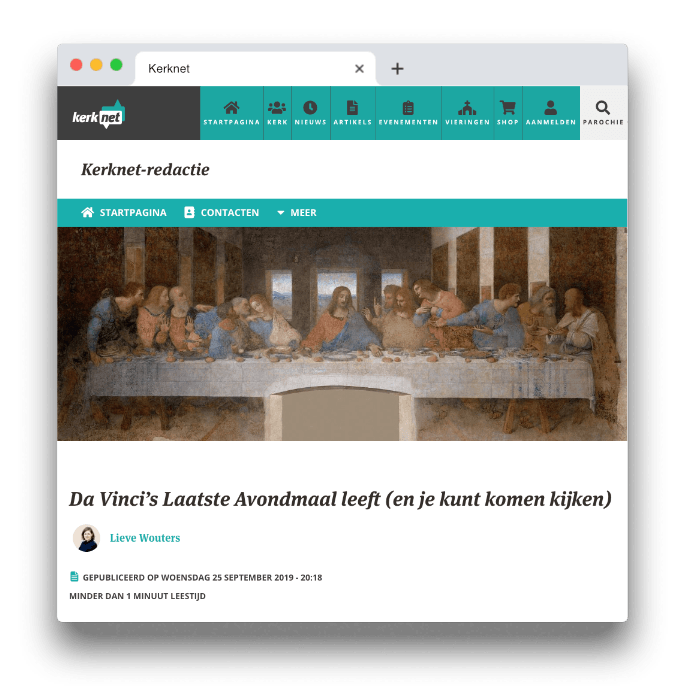Leonardo da Vinci's
THE
LAST
SUPPER


The Recreation of Leonardo da Vinci's Masterpiece
The Living Tableau
Created by
ARMONDO LINUS ACOSTA
Cinematography by
VITTORIO STORARO
Production Design by
DANTE FERRETTI
Set Decoration by
FRANCESCA LO SCHIAVO
a production by
THE ACADEMY OF FILM AND THE ARTS
The Recreation of Leonardo da Vinci's Masterpiece
The Living Tableau
Created by ARMONDO LINUS ACOSTA
Cinematography by VITTORIO STORARO
Production Design by DANTE FERRETTI Set Decoration by FRANCESCA LO SCHIAVO
a production by THE ACADEMY OF FILM AND THE ARTS
About
The Last Supper: The Living Tableau Overview
Visionary Creator / Director Armondo Linus Acosta, known throughout his life and career for manifesting works of extraordinary beauty, brings the mystical power of Leonardo da Vinci’s iconic 15th Century masterwork, The Last Supper, to life for 21st Century audiences. “The Living Tableau”, with a nine-minute running time, is an exquisite filmic re-creation, in exacting detail and subtle nuance, of Da Vinci’s incomparable 15th Century masterwork.
By marrying the genius of the Renaissance master with the creativity of cinematographer Vittorio Storaro, set designer Dante Ferretti and set decorator Francesca Lo Schiavo, each a winner of three Academy Awards®, Acosta and his artistic Dream Team have captured the transcendent light and the transformational essence of the most illustrious gathering in history; the final meal Jesus shared with the apostles before His crucifixion.
“The Living Tableau”, with a running time of nine minutes, was first presented in 2019 as part of the global celebration of the 500th Anniversary of Leonardo da Vinci’s death, commemorating his timeless influence on both art and life. In addition to being featured in cultural institutions, it has been projected onto a number of iconic building façades to the delight of outdoor audiences.
The scene opens on a poetic and timeless landscape, to the first resonating notes of Rossini’s Stabat Mater. The room and iconic table are slowly revealed, as the Apostles expectantly await the arrival of Jesus. There are whispers and subtle movements as the twelve wonder why they have been gathered, with each Apostle experiencing his own quiet confusion and range of human emotion. Jesus enters and takes His central position. Upon blessing the disciples and the meal, the announcement of a betrayal from one amongst them is felt by all, as the Twelve Apostles move into the exact positions depicted in Leonardo’s painting.
The director filmed the living portrait in ‘extreme slow motion,’ lending time to the viewer for quiet contemplation. Acosta says, “I consider this a work of art on film, a ‘tableau’; a painstakingly accurate work whereby you have the opportunity to meditate on the divine details of Leonardo’s extraordinary mystical masterwork. I want people to have the direct living experience as passionately and divinely inspired as possible”.
Acosta’s awe-inspiring interpretation of The Last Supper is the pinnacle of his personal commitment and lifelong pursuit of artistic integrity, spiritual understanding, passion for beauty and abiding admiration for Leonardo.
Lovers of art and beauty, and people of all backgrounds, faiths and religions will have their own personal and profound connection with Leonardo, and with the Divine, when they experience The Last Supper: The Living Tableau.
The Creator’s Unprecedented View of The Last Supper
The way Acosta captured Da Vinci’s masterwork goes far beyond ‘film’, providing viewers with an unprecedented way to view it. Acosta said “Every square inch of what we recreated is divinely almost identical to Leonardo’s painting, with all the work, and all the detail. I intentionally filmed “The Living Tableau” in ‘extreme’ slow motion, as I do not consider this work a film, per se, but a ‘tableau’! This is a painstakingly accurate piece whereby you have the opportunity to meditate on the divine detail of the extraordinary mystical masterpiece of Leonardo da Vinci.”
Acosta adds, “In the history of the creation of The Last Supper, no one has ever zoomed back from the background, and in this tableau, we did just that! The beauty in the creation of the cinema lens is just beyond, beyond, because there is a central point in the center of a lens which is called the nodal point. That nodal point didn’t exist in anyone’s mind back then, but Leonardo saw that; he saw that there was a point of origin. One can get very cosmic with it and go out into space...but, right here in this studio, there was a re-creation of the simplicity and perfection of the nodal point of a lens. We ended up not looking at it as anyone would look at this. We started from an infinity and we pulled back to the maximum somewhere along the way, to a point that the world will be comfortable with.”
Acosta offers the highest praise to Storaro for his impeccable and “beautiful solution” to the challenge of capturing Leonardo’s challenging perspective, saying “I watched it very carefully, and the way Vittorio handled and manifested that and the fact that he took the impossible task of a zoom back from an infinity to a master of something that was based on the central theme of perspective, and the nodal point, is masterful. I must honor him. It was brilliant! Brilliant!”.
In addition to “The Living Tableau” being screened around the world, it will also serve as the opening sequence of The Last Supper — A Divine Prophecy, Acosta’s latest feature film, currently in production. Far from a 'stereotypical' portrayal of the life of Jesus and His disciples, the film will be unlike any other, exploring the Apostles experiences and deep human realities in a non-linear manner and in a variety of timeframes. The telling unfolds through a collection of short film sequences — each a standalone production with elegant cinematography, production design, music and a unique narrative — creating a mosaic of meaning and understanding. Each sequence is experiential, profound and intimate, transcending our traditional understanding of time and religious dogma. Scenes will include the exploration of the true essence of Baptism, Judas’ excruciating inner conflict, the Crucifixion and the true nature of love, as well as the Apostles’ struggles and private moments of devotion.
For many of those who will have a chance to experience Leonardo’s masterpiece, “The Living Tableau” will be life-changing, for others thought-provoking. One could imagine that Da Vinci, one of history's greatest visionaries in both art and science, might have foreshadowed the era of cinema and the Last Supper coming to life in this way; that he would be open to his work being completed in a medium only possible in our modern time. Acosta, Storaro, Ferretti, Lo Schiavo and a dedicated production crew, have created an unprecedented tour de force — a divinely inspired gift of devotion, beauty and love for the world.
“The Living Tableau”:
An Experience for People of All Faiths and Beliefs
Creator / Director Acosta emphasizes that “The Living Tableau” is not religious. It’s not Catholic. A person of the Jewish faith will be as stimulated as a Zoroastrian or as a Buddhist Monk would be because it has God-presence. He explains that “It is based on Self-Realization, which is the highest, most perfect goal of man on earth — that one can actually achieve Perfection in this body, in this life. Self-realization is something that you can’t take, you can’t find — it is given to you.
“The Last Supper is not about a religious principle that only belongs to the Catholics — it is all about Self-Realization. Jesus was a Self-Realized being. There are always 40 Self-Realized ones on the planet at any time, and each one of us has their own specific karma to live out — I certainly have mine. All forty of us have our own destiny and our own work and we ALL have the same Boss. Whether you're Jewish, whether you're Muslim, whether you're Catholic, whether you're Zoroastrian, or whatever you are, whatever you believe in, we all have the same Boss — That which created us. You can call it ‘Buddha’, you can call it ‘Baba’, you can call it ‘Jesus’, you can call it ‘God the Father’, you can call it ‘The Creator’, or you can call it whatever you want — something did this and there is no copyright or trademark on the ownership of God. Whether you believe in Jesus Christ or Buddha, or Moses, or Allah, we all have to wake up and say, ‘something did this, somebody created all of this’.
“The world is needing a form of inspiration right now — the world needs to be inspired. I think it’s time to take a look back at beauty. We filmed this “Living Tableau” in a beatific way. It would have been so easy to have made this a simple documentary, where you put two lights up and you point a camera, and you roll. But together with Vittorio Storaro and Dante Ferretti and myself, we’ve made a truly beautiful work of art and that should be inspiring in itself.
“We really need beauty now. I’m an old man, I’ve been around, and I have worked with some of the great artists of the world. It’s just a nice thing to see something beautiful — that can be inspiring. And so, with our The Last Supper: The Living Tableau, we give people the opportunity to feel and be inspired; inspired by beauty and inspired on a God level — no matter what your faith and no matter what your beliefs are.”
The director also points out that “The Last Supper was, in fact, a Seder (a religious meal that is served in Jewish homes to commemorate the holiday of Passover). The so-called religious principle all started with rabbinical teaching. Religion itself really comes under the one ‘big umbrella’ of teaching people to realize that all this didn't just come from a rock — something, someone, did all this! Everything on this planet is something rare. Who made everything you see that was here long before we were here? And who made us?!!! The most complex thing one could imagine is the human being!
“No one can ignore the power of the Catholic premise, and the Catholic premise being illustrated with the fact that that The Last Supper is most illustrious gathering of men in history. And no one can ignore the omniscient, divine power of Jesus, a Realized One, that permeates this story. It's still a best-selling book — it's still the greatest story ever told. But you don’t have to be Catholic to see this tableau — it’s not at all a preachy, ‘put your hands together and go home and pray and become Catholic’ experience. It really is to just inspire you to realize that there is God. God created all of this long before religions and Leonardo.
“We need the comfort of security in this very insecure world. It’s like we feel there is a tsunami coming and we don't know what to do with that. We don't know how to be safe, so we pray… and we hope that God will make us safe. We pray to God, and we hope that the One that created all of this can help us out when we need it — and now, we need it. In a way, I see this tableau as a kind of healing. A powerful energy comes from this tableau, because of Leonardo’s divine energy and because of the Shakti (primordial Divine energy) that comes from ‘This’. “The Living Tableau” is empowered. Everyone who sees this replication of Da Vinci’s The Last Supper will receive this divine energy — no matter what one’s religion is, and no matter what one’s belief system is. Everyone who sees it will have their own deeply personal experience.”
ARMONDO LINUS ACOSTA
Armondo Linus Acosta, also known as Baba Ganapati, a Meditation Master, is passionate about the pursuit of art, beauty and truth. He is a film director, producer, screenwriter, graphic designer, teacher of the arts and founder of The Academy of Film and the Arts in Ghent, Belgium. He was born on September 23, 1938, in Bradford, Pennsylvania, the eldest of three children to musical and theatrical parents. Baptized a Catholic, he received his primary and secondary educations in Catholic schools and served as an altar boy at Saint Cecilia’s Church in Detroit, Michigan. At home in the theatrical world of the 1940s and ‘50s, and possessing prodigious creative talents, at the age of eight Acosta began an intense education in art, music and theater with the encouragement of his mentor John Devleeschauwer. He went on to study at the Tomlinson Technical Institute and The Ringling School of Fine Arts, both in Florida, and the famed Art Center School of Design in Pasadena, California.
Acosta has a rich and storied background in filmmaking. In the 1960s, he was one of Hollywood’s young mavericks in Roger Corman’s stable of aspiring filmmakers, alongside Francis Ford Coppola, Martin Scorsese, Ron Howard, James Cameron, Peter Bogdanovich, Robert Towne and Jonathan Demme, among others. Nicknamed “The Monk” because of his yogic practice, Acosta worked in a number of capacities on films including The Young Racers, The Haunted Palace and Battle Beyond The Sun. Years later, Acosta and Corman reunited at the Flanders International Film Festival Ghent in 2000 and again in 2009 at the Academy of Motion Picture Arts and Sciences Governor’s Awards when Corman received an Honorary Academy Award® for Lifetime Achievement.
Quickly establishing himself as an international designer and motion picture visual consultant, Acosta was known for his subtle but grand style. He lit and directed more than 250 major international award-winning commercials for major companies. His clients included the New York World’s Fair, Herman Miller, Eastman Kodak, Alka-Seltzer, Ford, Chanel, NASA, The Peace Corps, ABC, CBS, NBC, MGM, Warner Bros. and Columbia Pictures. Acosta’s work is represented in the International Design Annuals and the Television Hall of Fame.
In a marriage of his devotion to film and spirituality, Acosta was chosen by the Vatican to write, design and direct a series of ten short films illustrating the Psalms of the Bible. He had the joy and grace to work closely with the late Father Patrick Peyton and with Pope John XXIII himself. Father Peyton, lovingly known as “the Rosary Priest,” and currently a candidate for sainthood, produced the films through his Family Theater ministry, recruiting Hollywood’s best and brightest. These short films were screened at the Vatican Pavilion during the 1964-65 World’s Fair in New York. Among them was The Soldier (1962), lauded at the 1964 Venice Film Festival and starring a young, then-unknown actor, William Shatner.
Guided by another iconic mentor, Walter Blake, Acosta became part of the feature film world as a consultant, writer and cinematographer-director on many classic films, working with virtually every major Hollywood director: Alfred Hitchcock, Blake Edwards, Stanley Kramer, Shirley Clarke, David Lean, Vincente Minnelli, James B. Harris, Robert Aldrich and Orson Welles. His credits include: Touch of Evil, Two Women, El Cid, Judgment at Nuremberg, Four Horsemen of the Apocalypse, Days of Wine and Roses, Lawrence of Arabia, Experiment in Terror, The Connection, War Hunt, Whatever Happened to Baby Jane?, The Birds and The Pink Panther.
During his tenure as an executive with Paramount’s Crewe Company Films, Acosta turned away from his extensive training and work in major motion pictures, choosing to leave the industry — and, indeed, everything familiar — for what would be nearly 20 years. After receiving the spiritual name Ganapati from the legendary guru Swami Muktananda, he left his worldly life as a family man and professional to embark on what was to be a life-changing spiritual quest. Over the next 11 years he traveled the globe, most often on freighters, living the disciplined yogic life. During this solitary period, he found seclusion in the African bush and an ancient cave in the mountaintop village of Ronda, Spain.
In 1980, he received the ultimate initiation from Swami Muktananda and Mahavatar Babaji — the Immortal One — widely known through Yogananda’s Autobiography of a Yogi. Now also known as Jivanmukta Baba Ganapati, he is an enlightened Siddha Meditation Master and founder of the Academy of Sadhana, based in Ghent, Belgium. With centers around the world, for more than 30 years Ganapati has carried on the ancient Siddha traditions of kirtan (chanting), japa (repetition of mantra), karma yoga (selfless service) and, most importantly, the grace of the direct, intimate relationship with the Guru. Ganapati encourages students not to retreat from the world but to live in it, seeing it for what it is — a place to realize the inner Self. The traditional love and respect between the Guru and disciple is enhanced with playfulness and a focus on the arts.
Under his direction, his students of Siddha Shiva Yoga produced the highly acclaimed, full-length feature in-concert film ROMEO . JULIET, which premiered at the 1990 Venice Film Festival. Presented with a live symphony orchestra, it has played to sold-out audiences and standing ovations in major concert venues around the world. Based on Shakespeare’s work, it features Prokofiev's breathtaking score, a cast of 108 cats and the voices of world-renowned and Oscar-winning actors and actresses Vanessa Redgrave, Sir Ben Kingsley, Dame Maggie Smith, Quentin Crisp, Robert Powell and Francesca Annis. John Hurt, the only human actor in the film, gives a consummate performance as an iconic bag lady.
Emphasizing the importance of the arts and that creativity and self-expression are direct links to one’s own divinity, Ganapati founded the Academy of Film and the Arts, an international film school based in Ghent with more than 4,000 square meters of studio space, and additional locations in Rome, New York and Las Vegas. He works with his students on new film and artistic projects, including the feature film Shooting Stars, an autobiographical work in post-production.
Acosta / Ganapati also devotes considerable time and energy to interfaith understanding and dialogue. He attended the “World Day of Prayer for Peace” in Assisi, Italy, with Pope Francis and other world spiritual leaders, held in September 2016, and was invited to the landmark climate change summit, “Protect the Earth, Dignify Humanity”, hosted by Pope Francis and the United Nations Secretary-General in April 2015. That year he also spoke at the European Parliament in Brussels, part of the World Conference of Religions for Peace. He has been invited to the Vatican on several occasions, attending the funeral service of Pope John Paul II in April 2005; the inaugural mass of Pope Francis in March 2013, including a private meeting with His Holiness and other spiritual leaders the following day at Clementine Hall in the Apostolic Palace, and to celebrate the canonizations of Mother Teresa in September 2016 and of Pope John XXIII and Pope John Paul II in April 2014.
Ganapati was invited to, and attended, the Interfaith Prayer Service with Pope Francis in New York City at the National 9/11 Memorial Museum, which took place on September 25, 2015. He was also a delegate to the United Nations Global Peace Initiative of Women Spiritual and Religious Leaders in Geneva in 2002, and to the United Nations’ Millennium Summit of Spiritual and Religious Leaders in 2000. Ganapati was one of 80 world spiritual leaders invited to the United Nations’ 50th Anniversary in 1995. He continues to meet and collaborate with sages, saints and spiritual leaders who are mutually committed to the spiritual state of humanity.
For a complete filmography of Armondo Linus Acosta, see link below:
https://www.imdb.com/name/nm0010163/
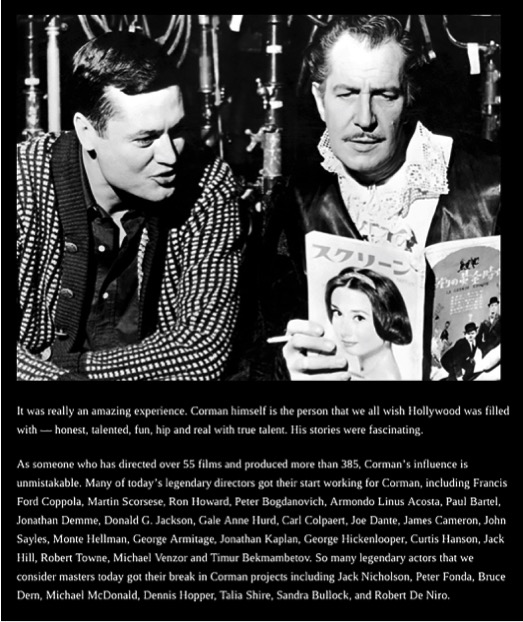
VITTORIO STORARO
Vittorio Storaro was born in Rome on the 24th of June 1940. It was in 1960 that he really began to move in the direction of his life’s work, graduating as a ‘Cinematographer’ from the Centro Sperimentale di Cinematografia (Italian Film Institute). The true moment of his cinematographic inception, which had been so long dreamt about and consciously prepared for, came in 1968 with his work on Giovinezza, directed by Franco Rossi. This was the first film that gave Storaro a way of expressing himself completely, instilling in him all the cinematographic concepts that are uniquely his, like a digital imprint of his photographic-figurative vision.
Working with directors like Luigi Bazzoni, Dario Argento, Giuseppe Patroni Griffi, Salvatore Samperi, Giuliano Montaldo, Luca Ronconi, Michael Apted, John Harrison, Alfonso Arau, Rachid Benhadj, and mainly Bernardo Bertolucci, Francis Ford Coppola, Warren Beatty, Carlos Saura, as well as more recently, Woody Allen, has brought him to a deeper and deeper cinematographic, stylistic maturity. This has allowed him, in time, to develop a more conscious inquiry into the expressive possibilities of lighting images.
Since the beginning, Storaro's artistic expression has been concentrated on the possible use of ‘Writing’ with ‘Light’. He discovered the symbolic values of the ‘Colors’ that it contains, dedicating himself to studying the visualization of the fundamental ‘Elements’ of ‘Life’. Recently, he has focused his attention to the creative intuition symbolized by the ‘Muses’, the creative possibilities foreseen of the ‘Visionary’ people in our world and, ultimately, the life of the ‘Prophets’.
Storaro has received several international awards, famously including the Academy of Motion Picture Arts and Sciences of Los Angeles, which has recognized his Cinematography with three Academy Awards® (Oscars) for the films: Apocalypse Now, directed by Francis Coppola; Reds directed by Warren Beatty; and, The Last Emperor, directed by Bernardo Bertolucci. The following Film Academies have also presented awards to Storaro, in recognition of his work on various films, including: Italian (David di Donatello Award), English (BAFTA Film Awards), Spanish (Goya Awards), American Television (Emmy) and the European Film Award (Best Cinematographer).
Vittorio Storaro has also been named the ‘Ambassador of the Image of Rome’.
Additionally, he has received four DEGREE HONORIS CAUSA from:
The University of Lodz, Poland
The University of Urbino, Italy
The Merith College of New York, US
The University of Palermo, Italy
He has also been awarded four Academic Honoris Causa from:
The Academy of Beaux of Macerata, Italy
The Academy of Beaux Art of Brera (Milan), Italy
The Academy of Beaux Art of Frosinone, Italy
The Academy of Beaux Art of Rome, Italy
Storaro is a member of numerous professional associations, such as:
President of the Italian Society of Cinematographers – AIC (1988–1990)
Member of American Society of Cinematographers – ASC
Member of European Academy of Film and Television
Member of Academy of Motion Picture Arts and Sciences in Los Angeles
Member of Italian Academy of Motion Picture
Member of SIAE (the Italian copyright collecting agency) as author of ‘Photography’ and ‘Figurative Arts’
Honorary President of the Italian Academy of Light
President or Member of some of the world’s most important Film Festivals.
He has received more the 40 Lifetime Achievement Awards, from myriad film festivals, including:
The International Film Festival of the Art of Cinematography Camerimage (Toruń, Poland)
American Society of Cinematographers (Los Angeles, CA, US)
Telluride Film Festival (Telluride, CO, US)
Locarno Film Festival (Locarno, Switzerland)
Thessaloniki Film Festival (Thessaloniki, Greece)
Macedonia Film Festival (Bitola–Republic of Macedonia)
Italian Association of Film Critics (Taormina, Italy)
Storaro taught "Writing with Light in Cinematography" for ten years (1995–2004) at the International Academy Arts and Sciences of Images in L'Aquila, Italy. His dream, and lifetime project, which is almost fully realized, has been authoring the publication of Write with Light, a set of writing and images, the result of a life of experience, divided into six main chapters. The work includes:
The first book: A Journey with Light is based on the theme of Light.
The second: Chromatic Emotion is based on the theme of Colors.
The third: The Equilibrium of the Elements is based on the theme of the natural elements of life.
The fourth: The Muses is based on creative intuitions.
The fifth: The Visionary is based on all human beings who see beyond normal reality.
The sixth book: The Prophets is based on the incredible great spiritual personalities.
From the book series, Storaro has also created a photography exhibition entitled "Storaro: Writing With Light". Another professional ambition, and cause for Storaro, is the legislative recognition around the world of the ‘Author's Rights: Cinematographers’ saying that cinematographers are the creators or author of images and therefore should maintain the right of co-authorship of the film.
For a complete filmography of Vittorio Storaro, see link below:
https://www.imdb.com/name/nm0005886/
DANTE FERRETTI AND FRANCESCA LO SCHIAVO
Dante Ferretti is an Oscar-winning Italian production designer, art director and costume designer whose innovative and distinguished work can be seen and experienced in over 50 films throughout a career that has spanned more than four decades. Ferretti’s wife and frequent collaborator is Oscar-winning set decorator Francesca Lo Schiavo. The internationally renowned scenic designer and set decorator continue to enjoy prestigious careers that have been honored with a number of world class awards.
Throughout his career, Ferretti has worked with many great directors, including Pier Paolo Pasolini, Federico Fellini, Terry Gilliam, Franco Zeffirelli, Martin Scorsese, Francis Ford Coppola, Anthony Minghella and Tim Burton. Ferretti was a protégé of Federico Fellini and worked under his tutelage for five films. He also had a five-film collaboration with Pier Paolo Pasolini and later developed a very close professional relationship with Martin Scorsese, designing nine of his last 11 movies.
Ferretti has won three Academy Awards® for Best Art Direction for his work on The Aviator, Sweeney Todd: The Demon Barber of Fleet Street and Hugo. In addition, he was nominated for Best Costume Design for Kundun. Prior to that time, he had received seven Oscar nominations and has won three BAFTA Awards. Francesca Lo Schiavo has also won three Academy Awards® for The Aviator, Sweeney Todd: The Demon Barber of Fleet Street and Hugo, with five previous Oscar nominations. She has also won a BAFTA Award for her work on Hugo.
Creating the production design for over 50 feature films, Ferretti has worked on over a dozen television, museum, fashion, festival and publication projects, working with the likes of fashion icon Valentino and director Liliana Cavani. In 2011, Ferretti designed the exhibition Leonardo. The genius, the myth at the Reggia di Venaria, in Torino, including a room and a special shrine that contained Leonardo’s drawings.
He has also designed 24 opera productions and stages at some of the world’s largest opera houses — La Scala in Milan, Opéra Bastille in Paris and the Teatro Colón in Buenes Aires, as well as in Rome, Turin and Florence. He has created stage designs for Verdi’s La Traviata, Puccini’s Tosca and La Bohème, among many others. In 2008, Ferretti designed the set for Howard Shore’s opera The Fly directed by David Cronenberg at the Théâtre du Châtelet in Paris.
In March 2019, Lo Schiavo was honored with a Special David Award at the Sixth David di Donatello Awards — Italy's equivalent to the Oscars.
Piera Detassis, President and Artistic Director of the Italian Film Academy said, "Francesca Lo Schiavo, a three-time Oscar winner, is a great protagonist and a great example of excellence of our cinema. Her work displays a surprising artistic talent that goes hand in hand with a deep technical knowledge: her research and attention towards every single detail has led her to create unforgettable film sets that made the magical and imaginary worlds of masters such as Martin Scorsese, Tim Burton, Federico Fellini, Franco Zeffirelli, Neil Jordan, Anthony Minghella and Kenneth Branagh, absolutely believable. I am very glad to bestow this Special David to a woman who has utilized her talent internationally."
For a complete filmography of Dante Ferretti, see link below:
https://www.imdb.com/name/nm0274721/
For a complete filmography of Francesca Lo Schiavo, see link below:
https://www.imdb.com/name/nm0521302/
Production Notes
Acosta and Storaro:
Their Shared Dream to Re‑Create The Last Supper
Armondo Linus Acosta is a longtime admirer of Vittorio Storaro’s work and has always wanted to work with the Maestro, who he considers to be “the major cinematographer alive today”. Armondo has great respect and love for Vittorio and “his energy, his passion and his intelligence. Storaro is a true artist and designer, a highly spiritual being, a consummate still photographer and a consummate cinematographer. He is the best in the business!”.
When the two first met 12 years ago, at a lunch meeting in Rome, Armondo realized that he and Vittorio shared the same passion for Da Vinci — who both agree is a “Master of Perfection” — as well as for The Last Supper. Armondo saw that Storaro was “one of the rare ones who is truly obsessed with The Last Supper”. At that lunch, Vittorio confided his “lifelong dream” to Armondo: to recreate and light Leonardo’s masterwork. Vittorio then presented Armondo with his business card, which, amazingly enough, had an image of Da Vinci’s The Last Supper painting on it!
After it was officially announced that Storaro would be working on “The Living Tableau”, Armondo wrote to Vittorio, “I am just giving you the brushes so that you can paint. That’s all I’m doing here”.
For Acosta, realizing “The Living Tableau” is also a dream come true. He has felt a profound connection to Da Vinci for as long as he can remember and considers him to be one of his first gurus. He has had the grace-filled and mystical experience of having been overshadowed by Da Vinci numerous times during his life, so far, beginning when he a young boy. Acosta says, “It is commonly known in high circles that Leonardo was not just a painter; he was a lover of God, he was a lover of beauty, he was a lover of women, he was a lover of men… he was an extraordinary human being, and a mystic. It's rumored that Marsilio Ficino was Da Vinci’s guru — on both a philosophic and on a God level”.
For Storaro, collaborating with Acosta on “The Living Tableau” has been the crowning glory of his longtime obsession with the iconic painting. During a Master Class that Vittorio gave to Armondo’s students at the Academy of Film and the Arts, the day after filming on ‘The Tableau’ wrapped (late January 2019), he implored them to: “Believe in your dream. Because if you believe in your dream, you send it out there, and you have much more chance to make it happen. You put a kind of shield around you — of beauty, of love, of something that you want to share, and you want to try… and somebody touches that. Armondo touched my dream for Leonardo — that’s why I’m here.”
Acosta’s Divine Revelation to Make The Last Supper
While Vittorio Storaro had his own dream regarding re-creating Da Vinci’s masterpiece, Acosta’s dream to make The Last Supper was born from it having been ‘assigned’ to him in a divine revelation.
Acosta shares how that came to be: “It’s difficult for people to believe it, but it’s absolutely a high truth. I have been a meditator all of my adult life and I have been a yogi all of my life. Being a yogi and doing what that life of spiritual study entails, it leads you to higher states of consciousness. And in that state of consciousness, there is a zone called Turya, and there is also a zone called Tandra. In a Turya state, you are seeing a separate reality. It is as real as real can be — it’s even beyond real. And in that Turya state, I hear words. You don’t hear them with your ears, you don’t hear them in your heart — it’s something you can’t describe. But the words and meanings are real…
“And, in that Turya state, I heard. ‘You will make a film of The Last Supper.’ You are semi-conscious in that state, meaning that you are able to cognize what is happening and being told to you in that state. ‘Where’s that coming from?’; ‘Who’s telling me to do this?’ — all that stuff comes up. But you get used to understanding that it is a very high command from what we call ‘Source’ — you can call it God, call it what you want.
“While in that state, I was told that I was going to make The Last Supper. There were other little innuendos that I couldn’t perceive as being as clear. But suddenly, I awakened from that state and popped to a full conscious state. Technically, when you are in those states of consciousness you have to go back in reverse, and go back through dream state, through deep sleep state, then semi-conscious state to your conscious state. I quickly went right back to a conscious state.
“I thought ‘Oh My God, what is that?!!!’ I’m finished with making films, per se — I have students that I’m teaching how to make films and little projects because I was a filmmaker. I sat on the edge of the bed and realized that’s so strange… being a ‘film baby’ all of my life with a showbiz mother, I saw every film that came out while I was in her arms. Then I realized that The Last Supper had never been made as the subject of a major film, and I thought, ‘Oh….’. Then, in my conscious mind, not as a Siddha Guru but as a filmmaker, it all started to make sense! Because in the early 1960’s, I was commissioned by the Vatican and Pope John XXII to make an important series of short films on the Psalms that were shown in the Vatican Pavilion at the 1964–65 World’s Fair in New York City. And I thought ‘well, that’s logical — in a way…’.
“So, then I had to come to the realization that it wasn’t just a little film — that it was The Last Supper! And that’s how it all started. I had to really consider how I was going to take on such a task, in that I’m running an international yoga, I have meditation centers, I have hundreds of disciples that I take care of and all that goes with that.
“But then, I suddenly thought of the challenge of it, and then I said, ‘quite possibly…I could do it! I know how to do this!’ Not in the ‘old Hollywood biblical film’ way, but the way I do things. It’s not going to be a Catholic film, but it has its God presence, and I will be honest and truthful to that. I think that’s why ‘They’ gave me this assignment. It was a thrill to take this project on! I have the talent and the wherewithal to do it, we have a studio, and we have an extraordinary group of collective talents. And so, we put them all together… and we did it! It was challenging, but we met every single challenge. I’m quite proud of what we all accomplished.”
The Secret of How Acosta Created “The Living Tableau”
“I was once a hired magician. They would sometimes hire me in Hollywood to do things that were strange and weird and find solutions to the most impossible creative challenges. Sometimes you could see it and sometimes you couldn’t see it. I thought, ‘How am I going to get 12 people to sit there for hours and hours, days and days, and stay in that exact same position? And how am I going to have every fold of the fabric be in that position, so that when that ‘tableau moment’ happens, it is as identical as possible to Leonardo’s painting?
“I suddenly had a thought — at the time, it sounded absolutely mad. But I called my art director and I said, ‘Koen, I’ve got to make plaster casts of my entire cast. Get them in their positions, match the painting, and make plaster casts of all their positions!’. Then my costumer Albertina put the folds of the fabric having been selected, upon selected, upon selected from pounds of fabric… and she carefully crafted every single wrinkle, and each robe was glued onto each cast. So then, all you would have to do is go behind it. And I did it myself — you get right inside there, and it fits you! You put your arm through this way or that way… and you’re completely in there. Suddenly, your entire body is matching the painting! The actual shape and form of each Apostle’s position matches Leonardo’s painting exactly! Identically! Frame by frame!
“It was a huge amount of work bringing everybody in and getting all those molds made. Then, we had to crack them so they could be maneuvered; it was most uncomfortable. The only thing that is esoteric about it, is that suddenly when everybody was together, they were all stuck together — it was like there were 12 Apostles as one unit! It was really kind of beautiful... I saw it myself. I looked it over for hours upon hours after the shoot. When you look at it, you don’t see 12 people in positions — they look like they’re all stuck together. Why? Because they are all stuck together! They are all stuck together with plaster casts. But you don’t feel it and you don’t see it — it looks like the real deal.
“So, that was challenging, but it was fun! I’ve done other weird things like that; so, for me, it was a solution. I needed to come up with a solution that would be honest and true to the replication of his masterpiece, and it wasn’t taking twelve amateurs and putting clothes on them and saying, ‘Ok, now move your arm this way!’. And then the clothing would flop and change and wouldn’t match. The people playing the Apostles would get in there and they would immediately feel like they were dressed exactly as they are in the painting. It was a lot of work and most uncomfortable…but it was fun! They had to spend hours in that position.
“At one point before the filming began, I caught a glimpse of my reflection in the mirror, and I suddenly realized that I looked like the Apostle Thaddeus in The Last Supper painting! I remembered that Alfred Hitchcock had a cameo in every one of his movies — you’d see him walking onto a bus, sitting on a train, reading a newspaper or walking a dog… I worked on a Hitchcock movie, The Birds, back in 1963. I had no desire to be an actor in a movie, but I thought ‘I’ll do it!’. You can see me up there if you want to look.”
From the Creator
The Importance of Beauty
“I can truly say that ‘beauty’ is the word of my life. I’m accused, I’m ridiculed, I’m bemused by my insatiable desire for beauty. It’s beyond. Just thinking about it makes me emotional. It’s very personal for me because if I was living a life without beauty, I’d rather not live.
“In my mind the greatest thing a human being can do, under my umbrella of ‘beauty’, is to create beauty; to make an attempt to enhance what God created beautifully and be responsible for creating that same feeling. There is even an electrical charge, a chromosomal charge in a human being that beauty creates — in every human being!
“Everyone is, in one way or another, inspired by beauty, and I can say that without anyone contradicting me. All that we know that are considered to be absolutes, must be attributed to God, however you see it — the Creator, the Master of All, the God that created this… someone… something created it. And if you really look at it, you'll see that every one of those, what are called ‘absolutes’, are beautiful — there is nothing ugly about them.
“In the principal of ‘What is beauty?’, it’s usually harmony and something that is absolutely positive without one element of negativity. True beauty does not have one possibility of being negative in the human condition. I have seen it myself when I spent time in the bush in Africa — I have seen creatures sitting dormant and just staring at something. What are they staring at? It’s not just another squirrel or snake or tiger or whatever… They’re mesmerized by something that is usually an absolute. They stare at the sunset — what are they staring at? What is it? It’s not their knowing that it feeds them all the Vitamin C and D and whatever they need — they don’t know any of that. There is no question that all God’s creations, all His creatures, are mesmerized by beauty.
“Leonardo da Vinci was a true lover of beauty. He was a remarkable, mystical being with a rich inner spirituality. Leonardo had boundless passion for discovering the beauty of life in all God’s creations and for creating beauty. Throughout all his works, Leonardo makes constant reference to the beauty and divine construction of the human body and the human spirit — it was his life.”
What Young People Can Learn from Leonardo
and the Key to Happiness — for People of All Ages!
“When an artist becomes iconic, famous, it’s not necessarily just because of their art,” explains Creator / Director Armondo Linus Acosta, who has had a lifelong devotion to the great artist and polymath Leonardo da Vinci, “it’s also because of their point of view, and if they are in some way teaching, or inspiring, or bringing something to light it’s really the dream of the artist, way deep in his soul… There is no question that Leonardo was a teacher. And speaking like the old man that I am, I remember being a young man and being inspired by Leonardo even then.
“Leonardo can bring a more respectful life to this generation that is categorically disrespectful. It’s disrespectful of their icons, and there are hardly any icons left today. There are no more Marilyn Monroes, Marlon Brandos or John F. Kennedys. There are no more of ‘the greats’ around… but somehow, there is Leonardo’s work. And because of the 500th Anniversary celebration, in 2019, you saw a plethora of all his art and all his inventions. And somewhere in the young mind, they began to respect the fact that he invented the airplane they fly in — you know, when they jump off of a mountain top and fly solo, which is clearly a new generation kind of thing… My grandmother would have never done that!
“And so, I think this awareness of Leonardo and his work will bring to young people of this generation a reflection on the basics that we have taken for granted; everything from flight to the way food is prepared, and the way the water is handled and its power.
“I believe that this generation can be truly inspired by Leonardo, who is one of the most creative people in history. Some of the great icons have inspired in all kinds of ways — from art, to music, to painting, to the sculptors, the architects, the writers and the poets; they all inspire you to create.
“Da Vinci was an engineer, he was a designer, he was a prophet — a constructive prophet — and he reminded us in his classic anatomical drawings of both the basic simplicity and the intricate complexity of the human body, which showed the birthing and the entire gestation of an infant in the womb.
“As we began to present ‘The Living Tableau’, there was a huge collection of information out there about Leonardo and his art and inventions, because of the 500th anniversary, countless people were awakened and inspired. You can imagine what many people said: ‘Oh, I didn’t realize he invented the parachute!?’ Leonardo did invent the parachute! He invented the watermill; he invented the windmill and he invented a lot of things that we just take for granted. I don’t think I’m alone in my geriatric views that the youth of today hasn’t been aware of any of that — they’re aware of computers, and thumping music and fake strawberries.
“I still have a little bit of old-fashioned idealism — I think that Leonardo is still waking up a few young ones and saying, ‘Hey! You might be able to do something like I did!’. Young ones are not inspired today. It sounds depressing, but just take a look at everything that’s going on in the world, like the legalization of marijuana — take a good look at that. I spend time in California and on my next trip there, I am going to drive on a highway where it is legal for someone to be stoned while they are driving 85 miles an hour. Bingo!!!!! This generation is not in a healthy state…They need to be inspired! They need to be creative!
“Being creative is a joyful thing. I find it a huge responsibility to use this gray matter up here, not just for eating and sleeping and working and living boring, dull lives. I’ve got a lot of dull and boring people around me and I try to inspire them creatively. And Leonardo does this — he really inspires!
“If you see an exhibition of Leonardo’s work, you cannot go back out there into the world like some kind of robot — you have to look at the beauty of woman in his work and come away having really seen the beauty of woman — even if you’re a macho male. Leonardo respected and honored the beauty and the creation of woman. And with Leonardo, you really see the creation of mind and what mind can do! So being creative is inspiring — creativity keeps you fulfilled. You can be creative with anything — you can even build a little building out of little lumps of sugar on the table. You can do it! I’ve been creative all my life and I’ve made a handsome living doing it.
“Creativity is the key to happiness! We can all be creative! Through art we can merge with God. The act of creating is how we tap into Source and our higher selves; it's the path to finding our pure inner joy. Whether it's through film, dance, music, or the visual arts, it doesn't matter; just create! Find your art form, find that place, and be free with it! It is especially important to be creative during these times, in this uncertain world that we live in — art is the way to transcend all of that! Art and being creative are the ways to attain and sustain real happiness.”
Working on “The Living Tableau”
with Acosta’s Academy Students and Devoted Film Crew
Acosta’s “The Living Tableau” is a work of love. It was made manifest by passionate artists who are true masters of their craft, by members of Armondo’s devoted, steadfast ‘film family’ — just as they worked on his world-acclaimed feature film-in-concert ROMEO.JULIET 30 years ago — and by the talented students of Armondo’s Academy of Film and the Arts.
Every element of this ‘Tableau’ is unquestionably inspired by, and infused with, passion — passion for art, for film, for Leonardo da Vinci, for The Last Supper, for a towering subject and its universal theme, and passion for the transcendent joy that creative beings experience while working alone or striving together to reach aesthetic heights and achieve perfection.
Armondo delights, “My students are all being creative and they’re also experiencing the joy of collectivity! The thrilling part of film is that it’s truly the only art form, next to architecture, that requires true collectivity. Usually painters only paint their painting. It’s very rare that you have four people painting one painting — that's the beauty of filmmaking. You can do it all by yourself, but it's not the same.
“I watched my students working with each other and working with, and learning from, those masters on the set, and it was thrilling! My students have never built a Hollywood movie set before, but I could guide them as to how to do it. I would walk into the studio at the Academy and watch these students making a set of the highest quality that would usually require professionals of the highest caliber! Building the set for this 'Tableau' was very challenging — it has forced perspective and with caveats in it that are not real. They weren’t just building a standard drawing room / three-wing set. These students did some very high-end work here — they really did it, and I am so proud of each and every one of them.
“I always bring ‘high-end’ to them. We don’t start off in grade school and work up to Master Class… What we are doing is always high-end. You can trace our history for the past 30 years — we made our ROMEO.JULIET film 30 years ago! I always start high-end in the way that it’s created and the way that it’s handled, and they really have to jump right in at that level.
“My students now are mostly in their mid-to-late 20’s and they just blossomed here. I was thrilled! We’ve done some very beautiful little films along the way together. I’ve trained one as a lighting person, I’ve trained another one as a production person, I’ve trained another as a graphic designer, and I can say that they are all capable, high high-end professionals!
“These students have really been trained and it was so wonderful to see them work with three multiple Oscar-winning talents and myself — their mentor and teacher — and manifesting everything they did. These students can go home to their Belgian mothers and fathers… and soon they will see their name right up there on the screen, on a major feature film — a major creative work! So, I’m really very proud of them. They have never done anything like this before…
“We have fun making films — we’re all together, we’re loving each other, we’re having a good time and its part of the life of yoga. It was joyful because this was a big project — this was not some tiny little tabletop thing or shooting a horse galloping off into the sunset. This was a huge work; all the drawings, the models, the conception of it and the scale of it. We also had a few people covering and capturing B-roll of the entire process, right from the very beginning when they first came through the front door, to when they left through the front door after we wrapped — everything is documented on video.
“The genuine passion and the loving energy from everyone who was involved in the creation of this tableau, together with the powerful divine energy of Da Vinci, is palpable. Anyone who sees this ‘Living Tableau’ will feel that energy.”
Armondo’s Film Mentor Roger Corman:
Priceless Hands‑On Filmmaking Experience
In 1959, iconic producer Roger Corman gave 21-year-old Armondo Linus Acosta the opportunity to live his dream: to work on a feature film. He had the joy and privilege to work with, and learn from, Roger from 1959 to 1963 as a filmic and title designer, creative consultant and second unit director on films such as The Young Racers, Haunted Palace, The Pit and the Pendulum, The Raven and Battle Beyond the Sun. Armondo reflects:
“Now, in my later years as a filmmaker, I am constantly reminded with an overwhelming gratefulness to one Roger Corman. For myself, and for many of us, including Francis Ford Coppola, Martin Scorsese, Ron Howard, Daniel Haller, Jonathan Demme and James Cameron, Roger saw something that we only dreamed about. And for most of us, the dream has come true: we make films!”
Through his Academy of Film and the Arts, Armondo is now giving that same exact experience to his students, who play an integral part in the making of “The Living Tableau” and The Last Supper: A Divine Prophecy.
“Like Roger, I am a professional filmmaker. As the founder and director of the Academy of Film and the Arts, I have students working on a professional film. They're not only studying filmmaking, but actually doing it. That's how they're learning, and that's how we learned with Roger; that's the difference — the big difference.
“I can't begin to tell you how thrilling it is to be able to see my students working with, and learning from, professionals on my film and on “The Tableau” and to be able to nurture and refine their talents by giving them the same priceless hands-on filmmaking experience that Roger gave me!”.
“Roger and I had a reunion at the film festival here in Ghent in 2001, and I was also with him at the Governors Awards when he got his Oscar in 2009. Can you imagine Roger Corman winning an Oscar?! In the 1960’s it would be the most impossible thing you could ever imagine, for Roger Corman to win an Oscar in any category. And he deserved it — he nurtured and mentored some of the greatest talents in film, and he got people to see his movies!”.
Gallery
Soundbites
Videos
Baba Ganapati, also known as Armondo Linus Acosta, presents Pope Francis with the gift of a bas-relief of The Last Supper and receives the Pope’s blessing for his film project, The Last Supper: A Divine Prophecy, at the Vatican, March 2013.
In Brussels, Baba Ganapati, also known as Armondo Linus Acosta, speaks at the Interfaith "Religions for Peace – Europe Study Day" held at the European Parliament, March 2015.
Armondo Linus Acosta is interviewed for a TV news segment about his directorial work with his Academy students during a shoot for the film Shooting Stars, San Diego, CA, April 2009.
Conceived and directed by The Academy of Film and the Arts Founder / Director Acosta, this trailer for the Academy One Studios, located in Ghent, Belgium, is an homage to the great Italian director Federico Fellini. The piece celebrates the joy, heart and creativity of filmmaking.
Press & Media
WORLD PREMIERE
PALAZZO REALE MUSEUM, MILAN
The Last Supper: The Living Tableau enjoyed its World Premiere at the Palazzo Reale Museum in Milan on October 8, 2019. In an exhibition entitled Il Cenacolo, Ispirazione Senza Tempo, Creator / Director Armondo Linus Acosta's filmic work of art was paired with a magnificent, newly restored tapestry depicting Da Vinci's The Last Supper, that has the same dimensions as the Renaissance master's fresco in Milan’s Santa Delle Grazie. Woven in fine silk, silver and gold threads in 1516, the Tapestry has adorned the walls of the Vatican since 1533 when it was donated by Pope Clement VII to Pope Francis VII on the occasion of the marriage of his niece, Catherine de Medici to his son Henry of Valois, heir to the throne.
Poster
Press Videos
First Public Projection
Tongerlo Abbey, Westerlo
The Last Supper: The Living Tableau Creator / Director Armondo Linus Acosta and his Academy Award®winning creative ‘dream team’ Vittorio Storaro, Dante Ferretti and Francesca Lo Schiavo visited the Tongerlo Abbey, a living monastery founded in 1128. The Abbey is home to a 16th Century reproduction of Da Vinci’s The Last Supper, which is considered to be the closest representation of his original fresco. Friar Ivo, the beloved curator, and his fellow friars who care for this priceless work of art, were most generous with their time and hospitality. Their devotion inspired Armondo to project the first public screening of “The Living Tableau” onto the Abbey’s façade, in dedication of the 500th anniversary of Da Vinci’s passing. “The Living Tableau” was projected in conjunction with the Music Festival of Flanders, honoring Leonardo as a musician and featuring Polish pianist Slawomir Zubrzycki playing the viola organista, which he also constructed. The bow stringed / keyboard instrument was designed by Da Vinci, although it was never realized in his lifetime.
PROJECTION ONTO SAINT BAVO'S CATHEDRAL
GHENT, BELGIUM
As a ‘thank you’ gift to the city of Ghent from Creator / Director Armondo Linus Acosta, a 34-year resident, “The Living Tableau” was projected on the façade of the famous St. Bavo’s Cathedral on September 28, 2019. Acosta's work of art was the centerpiece of an evening celebrating the beauty and creativity of Ghent, featuring the music from Boho Strings and honoring the birthday of the cathedral’s Bishop Lucas Van Looy. Press Release
Poster
Online

The Academy of Film and the Arts
The Academy of Film and the Arts (AFA) was established by Armondo Linus Acosta and his film family following their production of the acclaimed film concert ROMEO ∙ JULIET. What began as a series of spontaneous projects has now evolved into the AFA, housed in the revolutionary Academy One Studios in Ghent, Belgium.
At the AFA, students are exposed to many creative possibilities and are encouraged to find their own art form. They are provided with a supportive environment to develop and refine their own potential, with an emphasis on the great joy that the creative process brings. There is no fixed curriculum, but instead a collection of initiatives incorporating many artistic endeavors in which students can join, all within a generous physical space, allowing them to develop and realize their own projects.
At the core of the AFA is a belief that art and spirituality are deeply intertwined: that in art, a person develops a direct connection with God, the Divine Principle, the Creator, the "Itness."
In addition to a full-service film studio and a beautiful courtyard, the AFA features suites for dance and theatre classes, a sound booth for music recording / engineering / production classes, an on-site restaurant reminiscent of a Paris café, a vegetable garden and ateliers for painting, sculpting, woodworking and welding. Not only does the AFA produce its own film projects in which all students are involved, but it also organizes film festivals, master classes and countless activities dedicated to all the arts.
"Through art we can merge with God. The act of creating is how we tap into Source and our higher selves; it's the path to finding our pure inner joy," says Acosta, who has devoted his life to the pursuit of art, beauty and truth. "Whether it's through film, dance, music or the visual arts, it doesn't matter; just create! Find your art form, find that place and be free with it! This is especially important during these times, in this uncertain world that we live in. Art is the way to transcend all that and the way to attain and sustain real happiness."
Media Contact
Carina Courtright · Producer
This email address is being protected from spambots. You need JavaScript enabled to view it.
us: +1 760 715 5503
Debora Diego · Producer
This email address is being protected from spambots. You need JavaScript enabled to view it.
eu: +39 388 2476785
